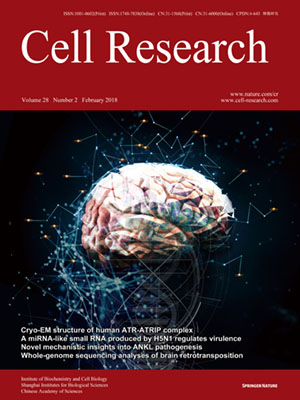Volume 28 Issue 2, February 2018: 172-186
ORIGINAL ARTICLES
Integrated genomic analysis identifies deregulated JAK/STAT-MYC biosynthesis axis in aggressive NK-cell leukemia
Liang Huang1,*, Dan Liu2,*, Na Wang1,*, Shaoping Ling2,17,*, Yuting Tang1,*, Jun Wu2, Lingtong Hao2,5,17, Hui Luo1, Xuelian Hu1, Lingshuang Sheng1, Lijun Zhu1, Di Wang1, Yi Luo1, Zhen Shang1, Min Xiao1, Xia Mao1,Kuangguo Zhou1, Lihua Cao2,17, Lili Dong2, Xinchang Zheng2,5, Pinpin Sui2,5, Jianlin He2, Shanlan Mo2,5, Jin Yan2, Qilin Ao3, Lugui Qiu4, Hongsheng Zhou6, Qifa Liu6, Hongyu Zhang7, Jianyong Li8, Jie Jin9, Li Fu10,Weili Zhao11, Jieping Chen12, Xin Du13, Guoliang Qing14, Hudan Liu14, Xin Liu2,5, Gang Huang15,16, Ding Ma18,19,Jianfeng Zhou1,4,19, Qian-fei Wang2,4,5
1Department of Hematology, Tongji Hospital, Tongji Medical College, Huazhong University of Science and Technology, Wuhan,
Hubei 430030, China;
2Key Laboratory of Genomic and Precision Medicine, Collaborative Innovation Center of Genetics and Development,Beijing Institute of Genomics, Chinese Academy of Sciences, Beijing 100101, China;
3Department of Pathology, Tongji Hospital, Tongji Medical College, Huazhong University of Science and Technology, Wuhan, Hubei 430030, China;
4Institute of Hematology and Blood Diseases Hospital, Chinese Academy of Medical Sciences & Peking Union Medical College, Tianjin 300020, China;
5University of Chinese Academy of Sciences, Beijing 100049, China;
6Department of Hematology, Nanfang Hospital, Southern Medical University, Guangzhou, Guangdong 510515, China;
7Department of Hematology, Peking University Shenzhen
Hospital, Shenzhen, Guangdong 518036, China;
8Department of Hematology, the First Affiliated Hospital of Nanjing Medical University and Jiangsu Province Hospital, Nanjing, Jiangsu 210029, China;
9Department of Hematology, the First Affiliated Hospital, Zhejiang University College of Medicine, Hangzhou, Zhejiang 310003, China;
10Department of Hematology, Beijing Friendship Hospital, Capital Medical University, Beijing 100050, China;
11Shanghai Institute of Hematology, State Key Laboratory of Medical Genomics, Shanghai Rui Jin Hospital, Shanghai Jiao Tong University School of Medicine, Shanghai 200025, China;
12Department of Hematology, Southwest Hospital, Third Military Medical University, Chongqing 400038, China;
13Department of Hematology, Guangdong General Hospital and Guangdong Academy of Medical Sciences, Guangzhou, Guangdong 510080, China;
14Medical Research Institute, Wuhan University, Wuhan, Hubei 430071, China;
15Division of Experimental Hematology and Cancer Biology, Cincinnati Children’s Hospital Medical Center, Cincinnati, OH 45229, USA;
16Division of Pathology, Cincinnati Children’s Hospital
Medical Center, Cincinnati, OH 45229, USA;
17Genome Wisdom Inc., Beijing 100195, China;
18Department of Obstetrics and Gynecology, Tongji Hospital, Tongji Medical College, Huazhong University of Science and Technology, Wuhan, Hubei 430030, China;
19Cancer Biology Research Center, Tongji Hospital, Tongji Medical College, Huazhong University of Science and Technology, Wuhan, Hubei 430030, China
Correspondence: Jianfeng Zhou, Qianfei Wang Tel: 86-27-83662 680; Fax: 86-27-83662680E-mail: jfzhou@tjh.tjmu.edu.cn Tel: 86-10-84097528; Fax: 86-10-84097720(wangqf@big.ac.cn)
Aggressive NK-cell leukemia (ANKL) is a rare form of NK cell neoplasm that is more prevalent among people from Asia and Central and South America. Patients usually die within days to months, even after receiving prompt therapeutic management. Here we performed the first comprehensive study of ANKL by integrating whole genome, transcriptome and targeted sequencing, cytokine array as well as functional assays. Mutations in the JAK-STAT pathway were identified in 48% (14/29) of ANKL patients, while the extracellular STAT3 stimulator IL10 was elevated by an average of 56-fold (P < 0.0001) in the plasma of all patients examined. Additional frequently mutated genes included TP53 (34%), TET2 (28%), CREBBP (21%) and MLL2 (21%). Patient NK leukemia cells showed prominent activation of STAT3 phosphorylation, MYC expression and transcriptional activities in multiple metabolic pathways. Functionally, STAT3 activation and MYC expression were critical for the proliferation and survival of ANKL cells. STAT signaling regulated the MYC transcription program, and both STAT signaling and MYC transcription were required to maintain the activation of nucleotide synthesis and glycolysis. Collectively, the JAK-STAT pathway represents a major target for genomic alterations and IL10 stimulation in ANKL. This newly discovered JAK/STAT-MYC-biosynthesis axis may provide opportunities for the development of novel therapeutic strategies in treating this subtype of leukemia.
10.1038/cr.2017.146
FULL TEXT | PDF
Browse 2242


